Abstract
AIMS--To estimate the proportion and nature of the proliferating (Ki67+) circulating lymphocytes in a series of patients with multiple myeloma and monoclonal gammopathy of unknown significance (MGUS) and to correlate this with other clinical and laboratory parameters, using blood from healthy adults as a control. To investigate the extent to which the B and T lymphoid components are involved in progression and/or control of disease. METHODS--Blood lymphocytes from 15 patients with multiple myeloma, 10 patients with MGUS and 10 healthy adults were analysed using a sequential double immunoenzymatic staining technique. Antibodies directed against Ki67 were used to detect cells in cycle, CD3, CD4, and CD8 to identify T cells, HLA-Dr as a marker for B cells and activated T cells, and CD11b as a marker for natural killer cells. Polyclonal antibodies directed against the kappa and lambda immunoglobulin light chains were also used to detect B cells. RESULTS--The proportion of proliferating (Ki67+) lymphocytes was significantly higher in patients with multiple myeloma (6.8 +/- 2.6) and MGUS (3.5 +/- 1.1) compared with the normal controls (1.69 +/- 0.3); this was also true when multiple myeloma and MGUS cases were compared. In multiple myeloma and MGUS over 50% of the Ki67+ cells were activated T lymphocytes (CD3+/HLA-Dr+); a minority (11%) were non-clonal B lymphocytes. In contrast to controls (6.7 +/- 1.9), in patients with multiple myeloma and MGUS the proportion of proliferating T cells expressing CD8 (23.6 +/- 12.5 and 15.3 +/- 7.7, respectively) and CD11b (13 +/- 8.7 and 11.6 +/- 3.9, respectively) was higher. In multiple myeloma there was a positive correlation between the proportion of Ki67+ lymphocytes, beta-2-microglobulin concentrations and disease stage. CONCLUSIONS--Although the number of patients investigated is small, this study suggests that Ki67 expression in blood lymphocytes from patients with multiple myeloma may be a good prognostic indicator for aggressive disease and may help to distinguish multiple myeloma from MGUS. The activated proliferating T cells in these diseases may represent an immunological reaction against the tumour.
Full text
PDF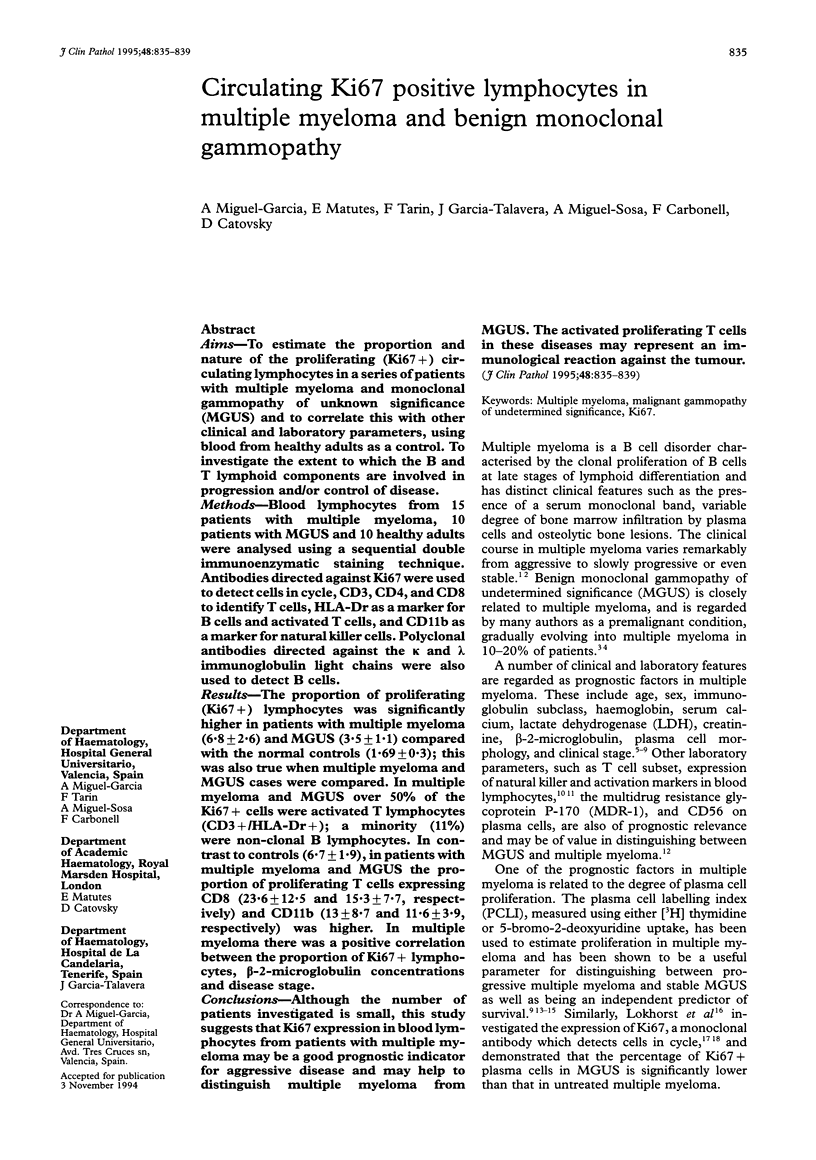
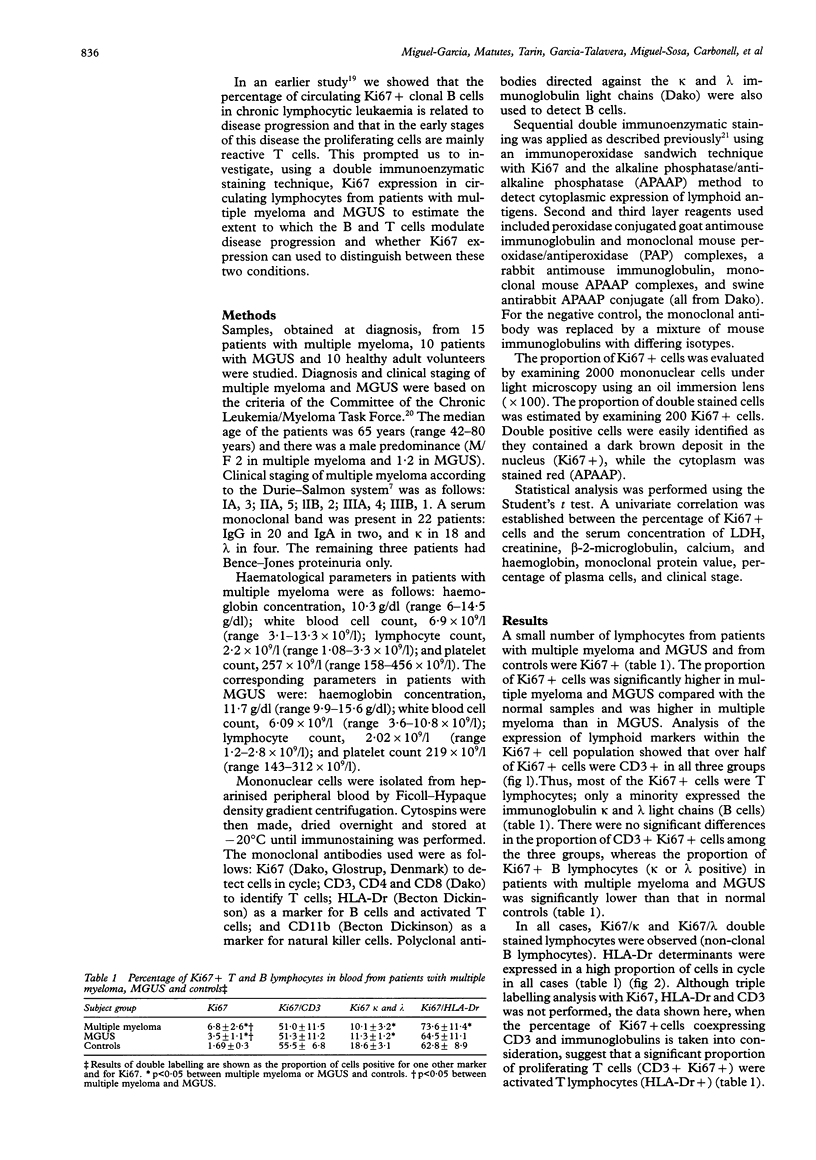
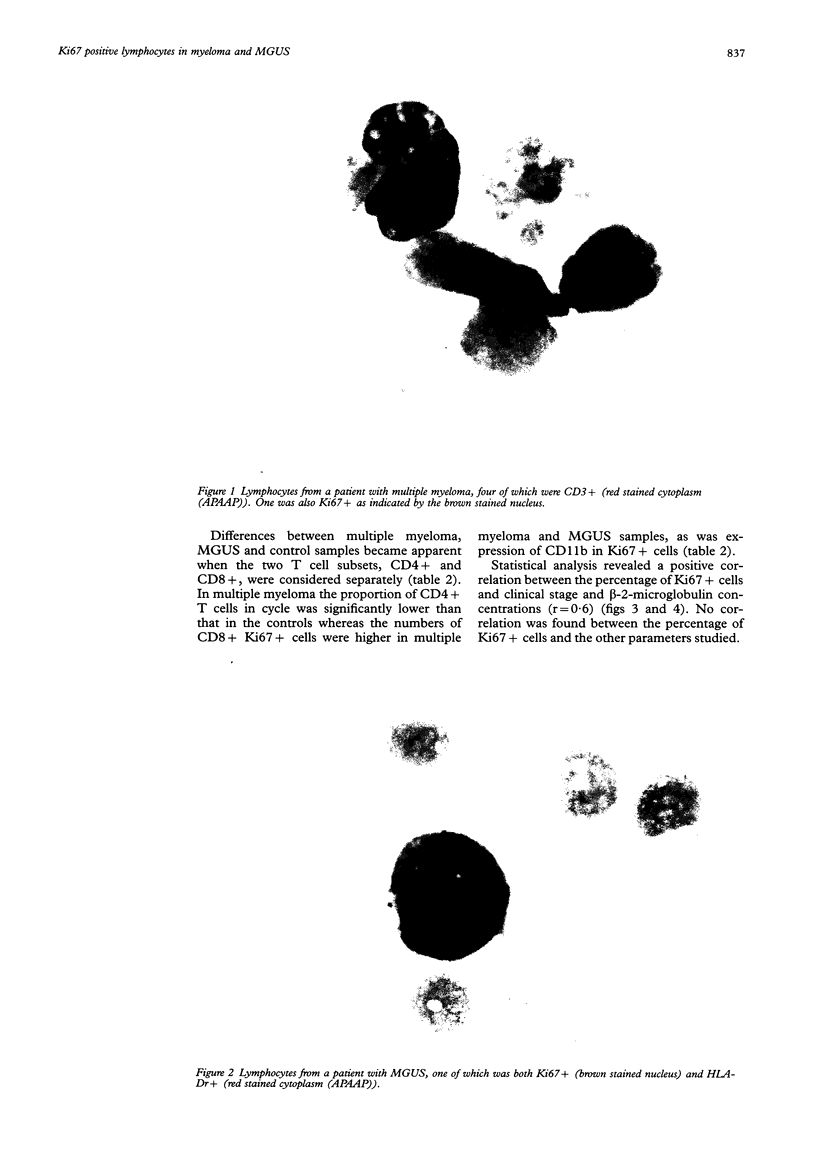
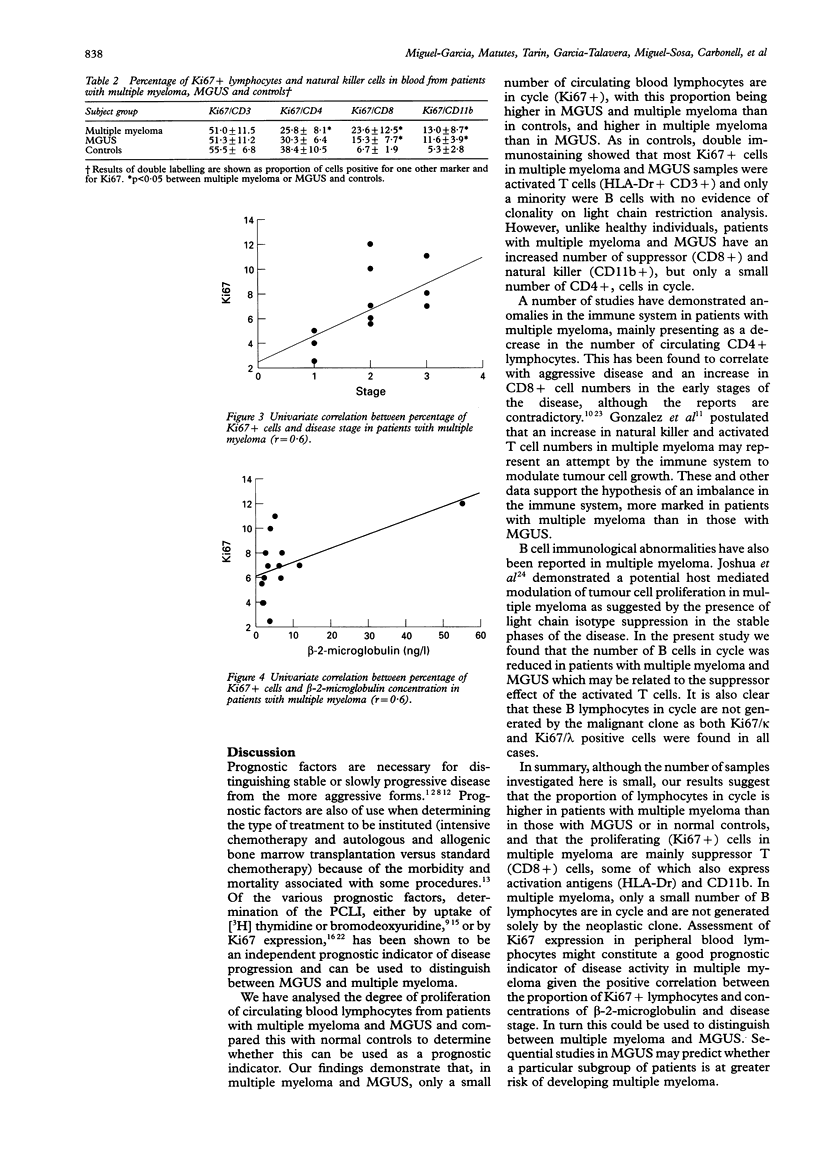
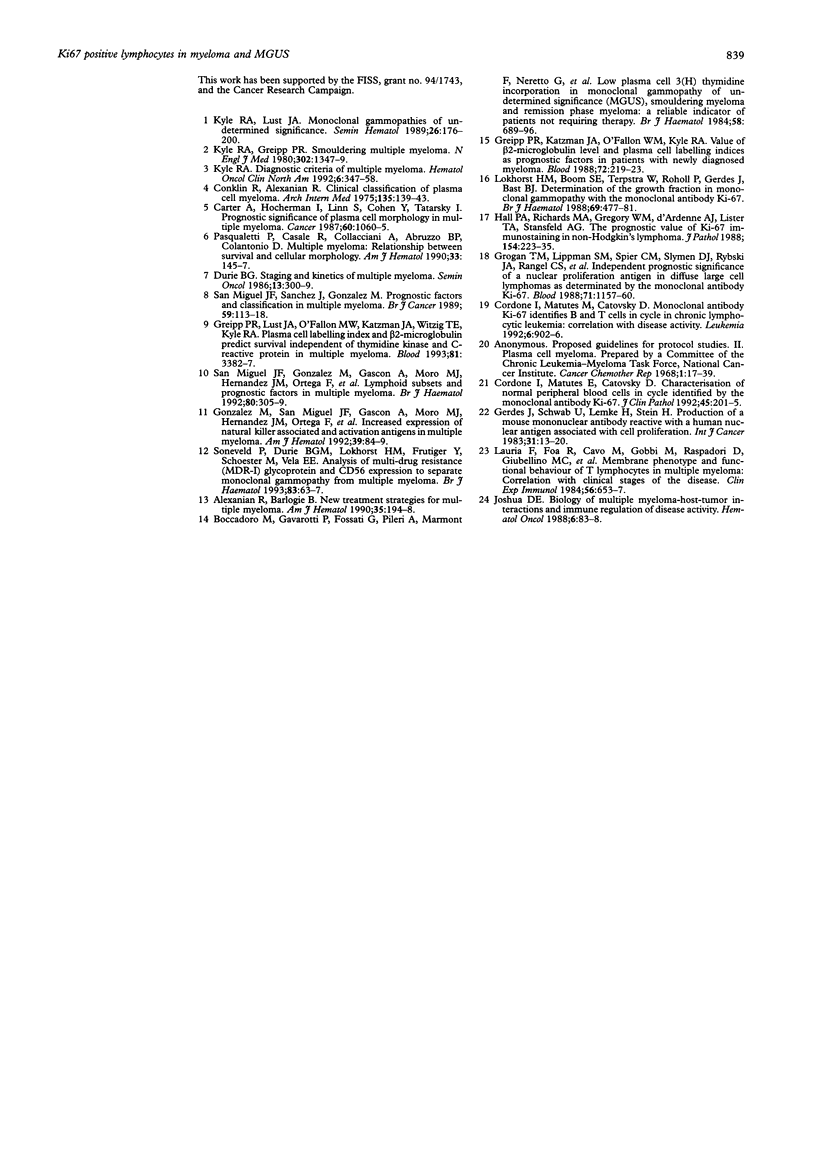
Images in this article
Selected References
These references are in PubMed. This may not be the complete list of references from this article.
- Alexanian R., Barlogie B. New treatment strategies for multiple myeloma. Am J Hematol. 1990 Nov;35(3):194–198. doi: 10.1002/ajh.2830350310. [DOI] [PubMed] [Google Scholar]
- Boccadoro M., Gavarotti P., Fossati G., Pileri A., Marmont F., Neretto G., Gallamini A., Volta C., Tribalto M., Testa M. G. Low plasma cell 3(H) thymidine incorporation in monoclonal gammopathy of undetermined significance (MGUS), smouldering myeloma and remission phase myeloma: a reliable indicator of patients not requiring therapy. Br J Haematol. 1984 Dec;58(4):689–696. doi: 10.1111/j.1365-2141.1984.tb06116.x. [DOI] [PubMed] [Google Scholar]
- Carter A., Hocherman I., Linn S., Cohen Y., Tatarsky I. Prognostic significance of plasma cell morphology in multiple myeloma. Cancer. 1987 Sep 1;60(5):1060–1065. doi: 10.1002/1097-0142(19870901)60:5<1060::aid-cncr2820600522>3.0.co;2-3. [DOI] [PubMed] [Google Scholar]
- Conklin R., Alexanian R. Clinical classification of plasma cell myeloma. Arch Intern Med. 1975 Jan;135(1):139–143. [PubMed] [Google Scholar]
- Cordone I., Matutes E., Catovsky D. Characterisation of normal peripheral blood cells in cycle identified by monoclonal antibody Ki-67. J Clin Pathol. 1992 Mar;45(3):201–205. doi: 10.1136/jcp.45.3.201. [DOI] [PMC free article] [PubMed] [Google Scholar]
- Cordone I., Matutes E., Catovsky D. Monoclonal antibody Ki-67 identifies B and T cells in cycle in chronic lymphocytic leukemia: correlation with disease activity. Leukemia. 1992 Sep;6(9):902–906. [PubMed] [Google Scholar]
- Durie B. G. Staging and kinetics of multiple myeloma. Semin Oncol. 1986 Sep;13(3):300–309. [PubMed] [Google Scholar]
- Gerdes J., Schwab U., Lemke H., Stein H. Production of a mouse monoclonal antibody reactive with a human nuclear antigen associated with cell proliferation. Int J Cancer. 1983 Jan 15;31(1):13–20. doi: 10.1002/ijc.2910310104. [DOI] [PubMed] [Google Scholar]
- Gonzalez M., San Miguel J. F., Gascon A., Moro M. J., Hernandez J. M., Ortega F., Jimenez R., Guerras L., Romero M., Casanova F. Increased expression of natural-killer-associated and activation antigens in multiple myeloma. Am J Hematol. 1992 Feb;39(2):84–89. doi: 10.1002/ajh.2830390203. [DOI] [PubMed] [Google Scholar]
- Greipp P. R., Katzmann J. A., O'Fallon W. M., Kyle R. A. Value of beta 2-microglobulin level and plasma cell labeling indices as prognostic factors in patients with newly diagnosed myeloma. Blood. 1988 Jul;72(1):219–223. [PubMed] [Google Scholar]
- Greipp P. R., Lust J. A., O'Fallon W. M., Katzmann J. A., Witzig T. E., Kyle R. A. Plasma cell labeling index and beta 2-microglobulin predict survival independent of thymidine kinase and C-reactive protein in multiple myeloma. Blood. 1993 Jun 15;81(12):3382–3387. [PubMed] [Google Scholar]
- Grogan T. M., Lippman S. M., Spier C. M., Slymen D. J., Rybski J. A., Rangel C. S., Richter L. C., Miller T. P. Independent prognostic significance of a nuclear proliferation antigen in diffuse large cell lymphomas as determined by the monoclonal antibody Ki-67. Blood. 1988 Apr;71(4):1157–1160. [PubMed] [Google Scholar]
- Hall P. A., Richards M. A., Gregory W. M., d'Ardenne A. J., Lister T. A., Stansfeld A. G. The prognostic value of Ki67 immunostaining in non-Hodgkin's lymphoma. J Pathol. 1988 Mar;154(3):223–235. doi: 10.1002/path.1711540305. [DOI] [PubMed] [Google Scholar]
- Joshua D. E. Biology of multiple myeloma--host-tumour interactions and immune regulation of disease activity. Hematol Oncol. 1988 Apr-Jun;6(2):83–88. doi: 10.1002/hon.2900060204. [DOI] [PubMed] [Google Scholar]
- Kyle R. A. Diagnostic criteria of multiple myeloma. Hematol Oncol Clin North Am. 1992 Apr;6(2):347–358. [PubMed] [Google Scholar]
- Kyle R. A., Greipp P. R. Smoldering multiple myeloma. N Engl J Med. 1980 Jun 12;302(24):1347–1349. doi: 10.1056/NEJM198006123022405. [DOI] [PubMed] [Google Scholar]
- Kyle R. A., Lust J. A. Monoclonal gammopathies of undetermined significance. Semin Hematol. 1989 Jul;26(3):176–200. [PubMed] [Google Scholar]
- Lauria F., Foa R., Cavo M., Gobbi M., Raspadori D., Giubellino M. C., Tazzari P. L., Tura S. Membrane phenotype and functional behaviour of T lymphocytes in multiple myeloma: correlation with clinical stages of the disease. Clin Exp Immunol. 1984 Jun;56(3):653–658. [PMC free article] [PubMed] [Google Scholar]
- Lokhorst H. M., Boom S. E., Terpstra W., Roholl P., Gerdes J., Bast B. J. Determination of the growth fraction in monoclonal gammopathy with the monoclonal antibody Ki-67. Br J Haematol. 1988 Aug;69(4):477–481. doi: 10.1111/j.1365-2141.1988.tb02402.x. [DOI] [PubMed] [Google Scholar]
- Pasqualetti P., Casale R., Collacciani A., Abruzzo B. P., Colantonio D. Multiple myeloma: relationship between survival and cellular morphology. Am J Hematol. 1990 Feb;33(2):145–147. doi: 10.1002/ajh.2830330214. [DOI] [PubMed] [Google Scholar]
- San Miguel J. F., González M., Gascón A., Moro M. J., Hernández J. M., Ortega F., Jiménez R., Guerras L., Romero M., Casanova F. Lymphoid subsets and prognostic factors in multiple myeloma. Cooperative Group for the Study of Monoclonal Gammopathies. Br J Haematol. 1992 Mar;80(3):305–309. doi: 10.1111/j.1365-2141.1992.tb08137.x. [DOI] [PubMed] [Google Scholar]
- San Miguel J. F., Sànchez J., Gonzalez M. Prognostic factors and classification in multiple myeloma. Br J Cancer. 1989 Jan;59(1):113–118. doi: 10.1038/bjc.1989.23. [DOI] [PMC free article] [PubMed] [Google Scholar]
- Sonneveld P., Durie B. G., Lokhorst H. M., Frutiger Y., Schoester M., Vela E. E. Analysis of multidrug-resistance (MDR-1) glycoprotein and CD56 expression to separate monoclonal gammopathy from multiple myeloma. Br J Haematol. 1993 Jan;83(1):63–67. doi: 10.1111/j.1365-2141.1993.tb04632.x. [DOI] [PubMed] [Google Scholar]




